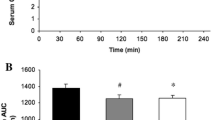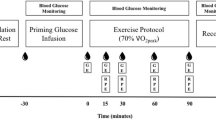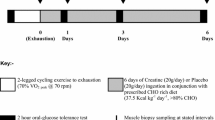Summary
Six healthy male subjects exercised after an overnight fast for a fixed 3 min period at a workload equivalent to 100% of their maximal oxygen uptake (\(\dot V_{{\text{O}}_{{\text{2 max}}} }\)) on 3 separate occasions. The first test took place after subjects had consumed a mixed diet (43±3% carbohydrate (CHO), 41±5% fat and 16±3% protein) for 3 days, and was followed 2 h later by prolonged cycling to exhaustion at 77±3%\(\dot V_{{\text{O}}_{{\text{2 max}}} }\) to deplete muscle glycogen stores. Following this, subjects consumed a low CHO diet (4±1% CHO, 63±5% fat and 33±6% protein) for the remainder of the day and for the subsequent 2 days; on the morning of the next day a second high intensity test took place. Finally subjects followed a 3 day high CHO diet (73±7% CHO, 17±6% fat and 10±1% protein) before their last test. Acid-base status and selected metabolites were measured on arterialised-venous blood at rest prior to exercise and at intervals for 15 min following exercise. Prior to exercise, plasma pH and blood lactate concentration were higher (p<0.05) after the high CHO diet when compared with the low CHO diet. Pre-exercise plasma bicarbonate, blood PCO2 and blood base excess were all higher after the high (p<0.001,p<0.01,p<0.01 respectively) and normal (p<0.05,p<0.05,p<0.05 respectively) CHO diets when compared with the low CHO diet. During the post-exercise period there were no differences in plasma pH or blood base excess between the three experimental situations; plasma bicarbonate was higher (p<0.05) at 2 min post-exercise after the high CHO diet when compared with the low CHO diet; blood PCO2 was higher throughout the post-exercise period after the high CHO diet when compared with the low CHO diet and at 2 min post-exercise was higher after the normal CHO diet than after the low CHO diet (p<0.5). The post-exercise blood lactate concentration after the high CHO diet was at all times higher than the corresponding values recorded after the normal CHO diet and until 15 min post-exercise was significantly higher than the values recorded after the low CHO diet. The present experiment further substantiates the view that a pattern of dietary and exercise manipulation can significantly influence the acid-base status of the blood and by doing so may influence high intensity exercise performance.
Similar content being viewed by others
References
Adler S, Roy A, Relman AS (1965) Intracellular acid-base regulation. II. The interaction between CO2 tension and extracellular bicarbonate in the determination of muscle cell pH. J Clin Invest 44:21–30
Asmussen E, Klausen K, Egelund Nielsen L, Techow OSA, Tonder PJ (1974) Lactate production and anaerobic work capacity after prolonged exercise. Acta Physiol Scand 90:731–742
Forster HV, Dempsey JA, Thomson J, Vidruk E, DoPico GA (1972) Estimation of arterial PO2, PCO2, pH and lactate from arterialised venous blood. J Appl Physiol 32:134–137
Gollnick PD (1973) Biochemical adaptations to exercise: anaerobic metabolism. In: Wilmore JH (ed) Exercise and sports science reviews. Academic Press, London, pp 1–39
Greenhaff PL, Gleeson M, Maughan RJ (1987) The effects of dietary manipulation on blood acid-base status and the performance of high intensity exercise. Eur J Appl Physiol 56:331–337
Hultman E, Sahlin K (1980) Acid-base balance during exercise. In: Hutton RS, Miller D (eds) Exercise and sports science reviews. Franklin Institute Press, Philadelphia, pp 41–128
Hultman E, Del-Canale S, Sjoholm H (1985) Effect of induced metabolic acidosis on intracellular pH, buffer capacity and contraction force in human skeletal muscle. Clin Sci 69:505–510
Jacobs I (1981) Lactate, muscle glycogen and exercise performance in man. Acta Physiol Scand [Suppl] 45:1–35
Jansson E, Kaijser L (1982) Effect of diet on utilisation of blood-borne and intramuscular substrates during exercise in man. Acta Physiol Scand 115:19–30
Maughan RJ (1982) A simple, rapid method for determination of glucose, lactate pyruvate, alanine, 3-hydroxybutyrate and acetoacetate in a single 20 μl blood sample. Clin Chim Acta 122:231–240
Maughan RJ, Poole DC (1981) The effect of a glycogen-loading regimen on the capacity to perform anaerobic exercise. Eur J Appl Physiol 46:211–219
McCance RA, Widdowson ED (1980) The composition of foods. MRC Special Report Series No. 297. London, HMSO
Richter EA, Galbo H (1986) High glycogen levels enhance glycogen breakdown in isolated contracting skeletal muscle. J Appl Physiol 61:827–831
Saltin B, Hermansen L (1967) Glycogen stores and prolonged severe exercise. Symposia of the Swedish Nutrition Foundation V, Blix G (ed), pp 32–46
Siggaard Andersen O (1963) Blood acid-base alignment nomogram. Scand J Clin Lab Invest 15:211–217
Sutton JR, Jones NL, Toews CJ (1981) Effects of pH on muscle glycolysis during exercise. Clin Sci 61:331–338
Author information
Authors and Affiliations
Rights and permissions
About this article
Cite this article
Greenhaff, P.L., Gleeson, M. & Maughan, R.J. The effects of a glycogen loading regimen on acid-base status and blood lactate concentration before and after a fixed period of high intensity exercise in man. Europ. J. Appl. Physiol. 57, 254–259 (1988). https://doi.org/10.1007/BF00640672
Accepted:
Issue Date:
DOI: https://doi.org/10.1007/BF00640672




